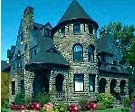 |
Another 'aisle' of PatternGlass.com's Virtual Pattern Glass Museum |
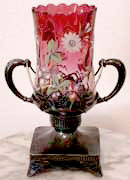 |
Celery was a luxury in Victorian times & so much so that they went to great lengths to make very elaborate Celery Vases. This is one of the most beautiful and scarce Celery Vases. It is Rubina art glass with Coralene decoration of Daisies and Lily of the Valley with Gilding and placed in a Metal Stand. Pickle Casters were very elaborate for the Victorian table. But Celery Vases in metal stands are quite rare. Thanks to Bill Banks of ClassicalGlassStore.com for sharing! |
 |
 |
| This is the base of the VERY rare IHMSEN sugar
bowl. It features 9 panels each showing pieces of pressed glass incl. 5 pieces of Excelsior pattern (a decanter, a goblet, a covered sugar, an ale & a spillholder), a Flute goblet, an Ashburton decanter, a Star spillholder & a hexagonal candlestick. It is dated 1851 according to Innes in his detailed write up about this piece in his book, Pittsburgh Glass 1797 - 1891, A History & Guide for Collectors, at pg 302. |
|
| A rare vaseline Libbey hatchet from the Columbian Exposition. It has a profile shot of Geo. Washington & in a 'rainbow' arch over his profile bust, it says THE FATHER OF THIS COUNTRY. The reverset says WORLD'S FAIR 1893. Also on the reverse, at the handle end, it says LIBBEY GLASS CO., TOLEDO OHIO . Libbey made it at the Fair along with other pieces. The hatchet usually sells for about $200. Thanks again to Dave Peterson, Mr. VaselineGlass. |
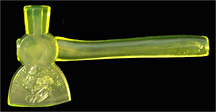 |
 |
 |
| Massachusetts by U S Glass Co. is one of their States' Series patterns c 1890s It is very rarely found in the form of a lamp. |
Here's one of the hardest pieces of Adams' pattern, HORSESHOE aka GOOD
LUCK aka PRAYER RUG c 1880s. It is the covered marmalade or jam jar with original glass lid. |
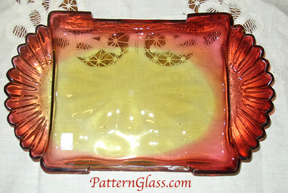 |
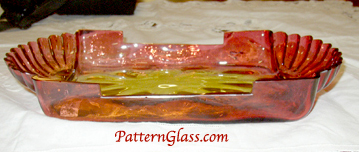 |
| A fabulous example of amberina glass. It appears to be blown which means it is not, strictly speaking, Early American Pattern Glass. We are actually interested in learning more about it - such as maker and age and would appreciate any information by clicking HERE to email us. | |
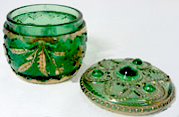 |
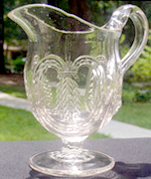 |
| DELAWARE is another of the U S Glass Company's States' Series
c 1899. This is the rare green/ gold pomade jar with its original "jeweled" lid. |
Our friend Mary Jane 'loaned' us this photo of a creamer w/ applied handle in Central's pattern #234, Wheat In Shield patented 10/17/71 by John Oesterling. It is a hard pattern to find in any form. |
This
is a gorgeous flint overshot epergne named OPHIDIAN by Ladd because
of the applied glass serpent which adorns it. These red serpents
are hand decorated with an intricate gold scale like design.
It was made by the Portland Glass CO. in the mid 1800s. It is
19" tall including the insert. It has been reported that
this glass with serpents was used in the Massachusetts State
House. A very rare piece of early glass.
|
 |
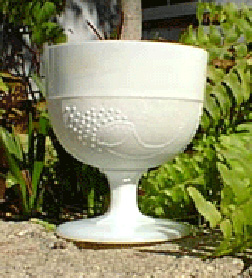 |
 |
A sugar bowl missing its lid in the Boston & Sandwich
pattern POWDER & SHOT from the early 1870s. It was made in flint
and non-flint and only very rarely found in flint milk glass. |
Another rare milk glass piece is this syrup
pitcher by the Indiana Tumbler & Goblet Company pattern, BEADED
PANEL ca 1901. Only 2 of these are known to exist; the other one
is in the Greentown Museum in Indiana. |
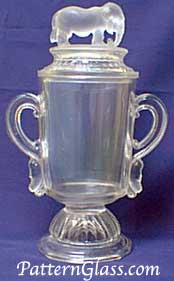 |
We'll bet you've never seen one of these - unless you know the present owner. A covered marmalade jar in the Brilliant Glass Work's JUMBO pattern ca 1884. We have seen no listing of the form in any reference. It has the "Barnum" heads at the base of the 2 handles and a flawless elephant for a finial. |
| Here's a rare piece of PALM BEACH pattern, a product of the U S Glass Co. #15119 ca 1909 in vaseline opalescent. Thanks to Steve & Radka Sandeman for contributing this compote photo for the museum. | 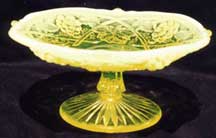 |
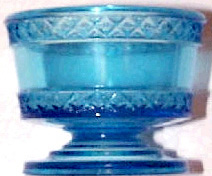 |
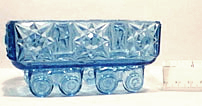 |
A
heretofore undescribed master salt in the SPIREA BAND pattern.
This little guy is only 2.25" tall, 3" diameter at the rim, and
2-3/8" diameter on the foot. |
A
rare size of this novelty train car in the Bellaire Goblet Co.
STARS & BARS pattern ca 1898. It is 2 1/2" X 4 1/2",
2 " high & has 8 WHEELS. |
| This Diamond Quilt water set is reverse amberina, made by NE Glass Co. Although these sets usually had a Finger Bowl with them, this set does not. Note that the unusual tray was made in a shape to hold only a Pitcher and two Tumblers. Amazingly, it is complete and all original with no damage. Thanks to Bill Banks of ClassicalGlassStore.com. |
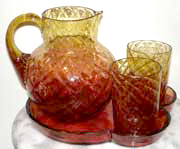 |
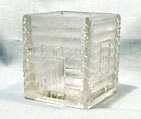 |
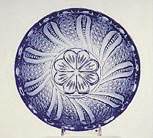 |
This looks like it could be a part of the Log
Cabin pattern but it is not. It is probably a mustard jar missing
its lid and now collected by toothpick holder collectors as the TECUMSEH
pattern. The name is pressed over the door and it is 2" square & 2
1/2" tall. |
Yes, this is a piece of McKee's FEATHER aka
DORIC pattern from the 1890s in blue!!! It is the 6 3/8" berry bowl and possibly one of a kind as this pattern in this color
is
not known
in any other
piece. |
 |
The incredible early
Pink Slag was only made in one EAPG pattern to our knowledge; INVERTED
FAN & FEATHER by Northwood ca 1904. According to Heacock, this
type of glass was probably produced while the Northwood plant was
under the control of the National Glass Co. The pattern is much more
commonly found in custard, green w/ gold and blue opalescent. |
 |
What we have here is the
only plate known of its kind! The pattern is SHELL & TASSEL & the
plate is 11 1/2" X 9 3/4". The profiles are of Abraham
Lincoln and James Garfield. |
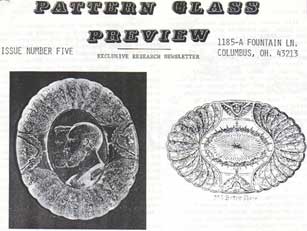 |
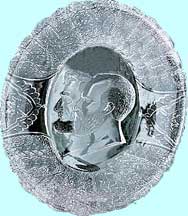 |
 |
 |
 |